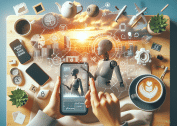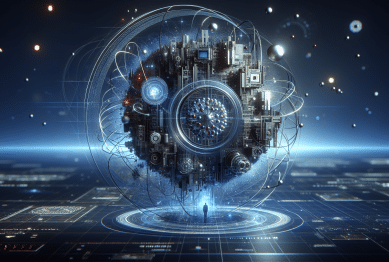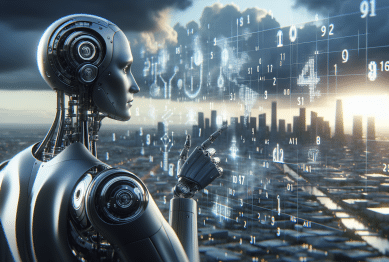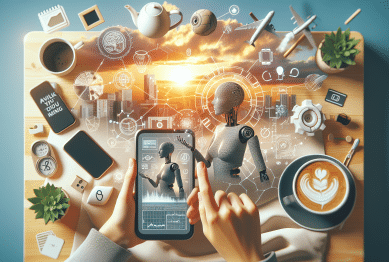Curious about how artificial intelligence is weaving into daily routines? Explore the evolving world of AI tools, smart devices, and machine learning. This guide unpacks practical applications, addresses concerns, and reveals innovations that change perception and experience—often in subtle, unexpected ways.
AI’s Quiet Integration into Daily Routines
Artificial intelligence, often discussed in terms of breakthroughs, is becoming part of everyday experiences. Many notice AI mainly in news headlines about algorithmic advances, yet it’s the subtle deployments in homes, phones, and cars that reshape routines. Smart assistants now recognize voices, manage appliances, and even suggest routes for commutes. These AI-driven technologies don’t demand attention but steadily influence how people shop, communicate, and organize their schedules. Their impact is growing deeper, blending into habits so seamlessly that the underlying AI often fades into the background of daily living. Understanding this progression provides a window into tomorrow’s lifestyle where intelligent systems quietly handle more tasks.
Smart home setups are an example. As households incorporate smart lights, thermostats, and security cameras, residents interact more frequently with machine learning algorithms. The systems can predict occupancy patterns or anticipate heating needs, automating adjustments to suit user preferences. It’s less about flashy new gadgets and more about an evolving relationship with technology. These tools collect data, adapt over time, and strive for efficiency with minimal user input. The net effect? Increased comfort and time savings for many households, sometimes without explicit recognition of the AI engine behind those conveniences.
AI isn’t limited to gadgets—apps and services are harnessing neural networks to filter emails, organize photos, and help remember appointments. Behind the scenes, companies use predictive analytics to tailor social media feeds and news highlights, drawing on past behaviors to recommend relevant content. As people rely more on these platforms, machine learning gently nudges decisions, makes suggestions, and even intervenes in digital wellness, like promoting break reminders. Such pervasive assistance shapes digital experiences every hour.
From Smart Phones to Smarter Decisions
Modern smartphones are an ever-present example of AI’s reach. Features like facial recognition, predictive texting, and voice commands rely on advanced algorithms rooted in machine learning. For many, unlocking a device with a glance or dictating a message is standard—few consider the deep neural networks processing these commands in milliseconds. Adaptive battery usage, camera scene recognition, and even spam call filtering all demonstrate AI working in your favor, quietly optimizing everyday interactions. This seamless integration raises the bar for what’s expected from mobile tech.
Beyond convenience, AI’s predictive power is changing how decisions are made. Mobile navigation apps factor in live traffic patterns, user histories, and weather variables to spontaneously adjust recommended routes. Travel and calendar applications sync preferences across platforms, helping people make choices about appointments, booking, and transit almost automatically. The refinement of natural language processing further personalizes experiences—devices learn quirks and vocabulary to better serve unique needs. As services grow more attuned through deep learning, expectations for instant, relevant recommendations increase across digital landscapes.
Retail and finance sectors tap into AI’s pattern recognition to enhance user experiences on mobile devices. Personalized shopping recommendations, fraud alerts, and tailored financial tips are powered by complex data analysis and modeling. With payments and transactions handled swiftly by AI-driven processes, users enjoy simplicity and safety. While these advances foster convenience, they also prompt consideration around privacy and informed consent — themes that continue to shape the evolution of AI technologies.
Smarter Homes, Safer Spaces
Home security, energy efficiency, and daily management are all experiencing transformation through smart devices and sophisticated machine learning models. Smart cameras monitor properties with real-time detection of unusual activity, using AI image analysis to distinguish between a stray animal and a possible threat. Alerts are personalized, and systems can even alert emergency services if needed. This extends peace of mind and allows for remote monitoring, making safety more intuitive and less intrusive for busy individuals.
Energy management relies on AI, too. Smart thermostats observe patterns in household occupancy, external weather, and user temperature preferences. By learning from these factors, systems automatically adjust heating and cooling, maximizing comfort while reducing energy consumption and cost. Over time, the algorithms become more responsive, locking in savings that sometimes surpass what manual management could achieve. For those concerned about ecological impact, these AI-driven features offer real, practical steps toward greater sustainability at home.
Appliance automation is another frontier. Fridges can track inventory and suggest shopping lists. Washing machines may optimize cycles based on load type and size. Voice-controlled assistants sync connected devices, setting routines that dim lights, adjust shades, or play music at certain times. All these reflect a convergence of the Internet of Things (IoT) and AI. As these systems collaborate and share data, personalized automation becomes the norm—offering efficiency without overwhelming users with complex controls.
Machine Learning and the Rise of Predictive Health Tools
Artificial intelligence has rapidly advanced within healthcare, supporting everything from fitness tracking to early disease detection. Wearable devices, driven by machine learning, now monitor heart rates, sleep quality, and physical activity round the clock. The data collected feeds personalized feedback, helping users adapt routines to best suit their wellness goals. Alerts for irregular heartbeats or suspected health events provide early signals to seek medical advice, potentially catching issues before symptoms would prompt a visit.
AI chatbots and virtual health assistants are growing in popularity, answering questions, offering reminders for medication, or supporting mental health with guided mindfulness exercises. Some applications can analyze input from wearables and user-reported data to identify potential health risks or flag inconsistencies. These predictive tools are increasingly used alongside telemedicine, giving healthcare professionals clearer patterns between patient visits. For individuals managing chronic conditions, this continuous support can bolster confidence in self-care while bridging gaps between appointments.
Notably, machine learning algorithms aid clinicians as well. In tasks like detecting anomalies in imaging scans or predicting hospital readmission risks, AI’s pattern recognition accelerates diagnoses and supports evidence-based medical decisions. While these tools do not replace human expertise, they often serve as a safety net or second set of eyes, improving outcomes by highlighting subtleties that may be less visible to humans. As technology matures, ethical considerations around data privacy, consent, and transparency remain central themes for both providers and the public.
AI and the Future of Personalized Learning
Education is experiencing transformation as AI-driven platforms deliver tailored experiences to learners everywhere. Adaptive learning software adjusts its difficulty in real time, responding to a student’s pace, strengths, and areas needing improvement. For self-directed learners, online courses may recommend specific modules or extra practice based on progress analytics. These developments offer unprecedented flexibility and personalization, motivating students with the right challenge level and feedback that is actionable instead of generic.
Teachers benefit, too. Automated grading tools scan written responses or code, providing detailed feedback almost instantly. Administrative burdens reduce, freeing more time for classroom interaction. Learning management systems can highlight trends or gaps in class understanding, guiding lesson adjustments for more effective teaching. While there are debates about the limits and ethics of data analytics in education, the core promise is clear: AI gives educators and students a means to optimize learning outcomes at scale, with greater sensitivity to individual needs.
AI-powered chatbots also play a support role, answering questions or navigating resources at any hour—a boon for anyone learning remotely or juggling tight schedules. For students with accessibility needs, AI can transcribe lectures live or convert text to speech, widening participation. As natural language processing improves, systems may soon offer highly conversational tutoring sessions, powered by contextual understanding of student queries. The evolution of education through AI continues, opening doors to new methods of instruction, evaluation, and engagement for diverse communities worldwide.
Addressing Privacy and Ethical Questions
Growing reliance on artificial intelligence raises valid concerns around privacy, data security, and transparency. Smart devices, apps, and home systems generate enormous volumes of personal information—often without overt input. How this data is stored, processed, and used remains a topic of global conversation. Many technology firms have responded by strengthening privacy protocols, introducing opt-in consent, and allowing users to fine-tune data collection settings. Informed participation is becoming central to ongoing adoption of AI in daily routines.
Algorithmic bias and explainability are further challenges. AI systems reflect their training data, and unchecked biases can emerge in subtle or unexpected places. Companies are investing in more inclusive data sets, building transparency into decision-making, and employing diverse teams to audit outputs. International organizations and standard-setting bodies are crafting best practices that balance innovation with user rights. Open dialogue and supportive regulation are fostering trust as AI becomes more embedded in public and private sectors.
Finally, stewardship of AI advancement matters. Initiatives across universities, research centers, and nonprofits promote education, skills training, and ethical leadership in AI development and use. Public participation and clear communication about the workings of AI tools can go a long way in empowered, informed involvement. As society rewrites the rules for a world that includes smart, learning machines, striking a balance between opportunity and accountability will shape tomorrow’s digital landscape.
References
1. European Commission. (n.d.). Artificial intelligence. Retrieved from https://digital-strategy.ec.europa.eu/en/policies/artificial-intelligence
2. U.S. Department of Energy. (n.d.). Artificial intelligence at home. Retrieved from https://www.energy.gov/eere/buildings/articles/smart-homes-and-ai
3. Mayo Clinic. (n.d.). Artificial intelligence in medicine. Retrieved from https://www.mayoclinic.org/medical-professionals/clinical-updates/quality/artificial-intelligence-in-medicine
4. UNESCO. (n.d.). Artificial intelligence in education. Retrieved from https://en.unesco.org/themes/ict-education/artificial-intelligence
5. National Institute of Standards and Technology. (n.d.). AI risk management framework. Retrieved from https://www.nist.gov/itl/ai-risk-management-framework
6. Brookings Institution. (n.d.). Privacy and security in the age of AI. Retrieved from https://www.brookings.edu/research/privacy-in-the-age-of-artificial-intelligence/









